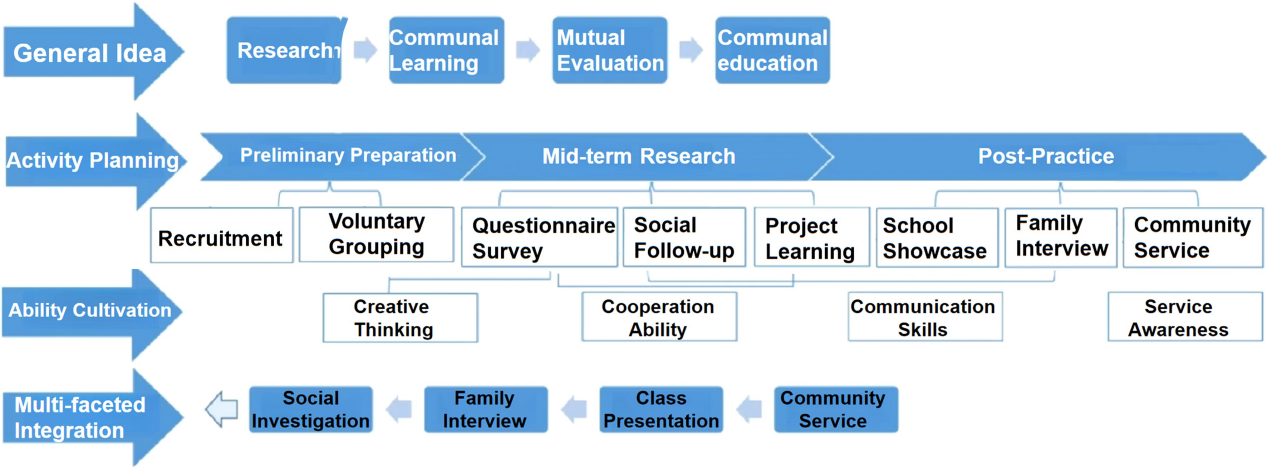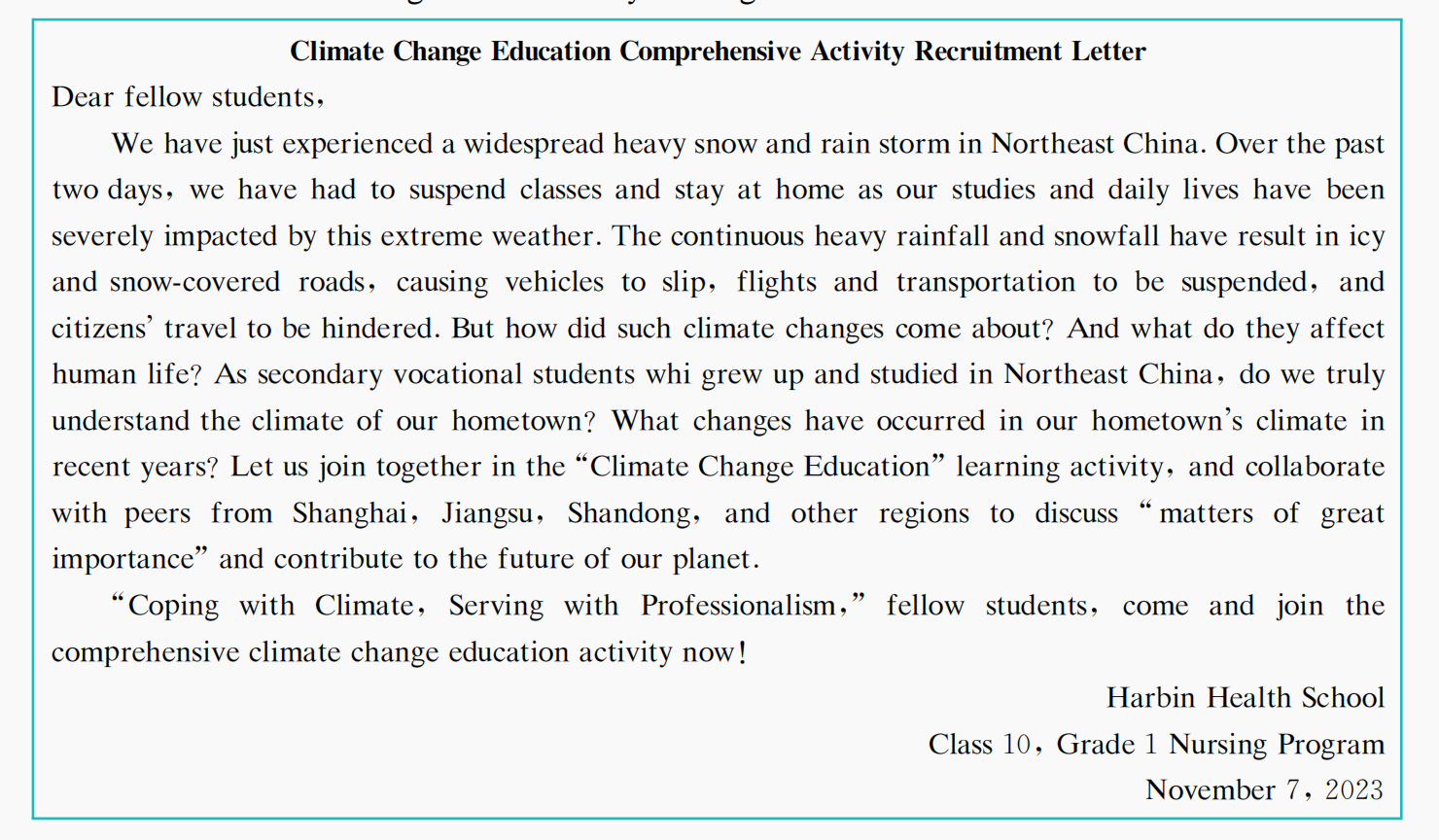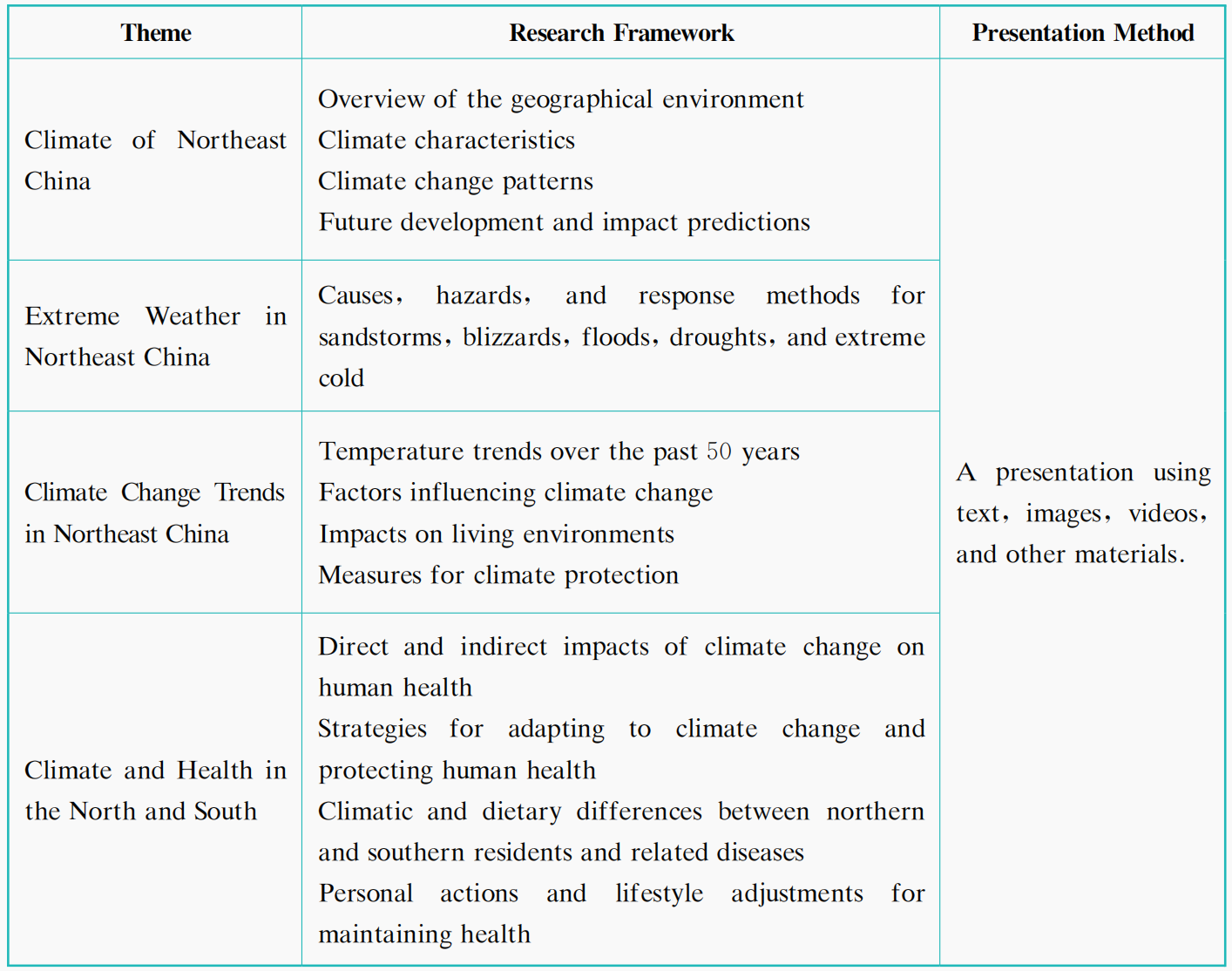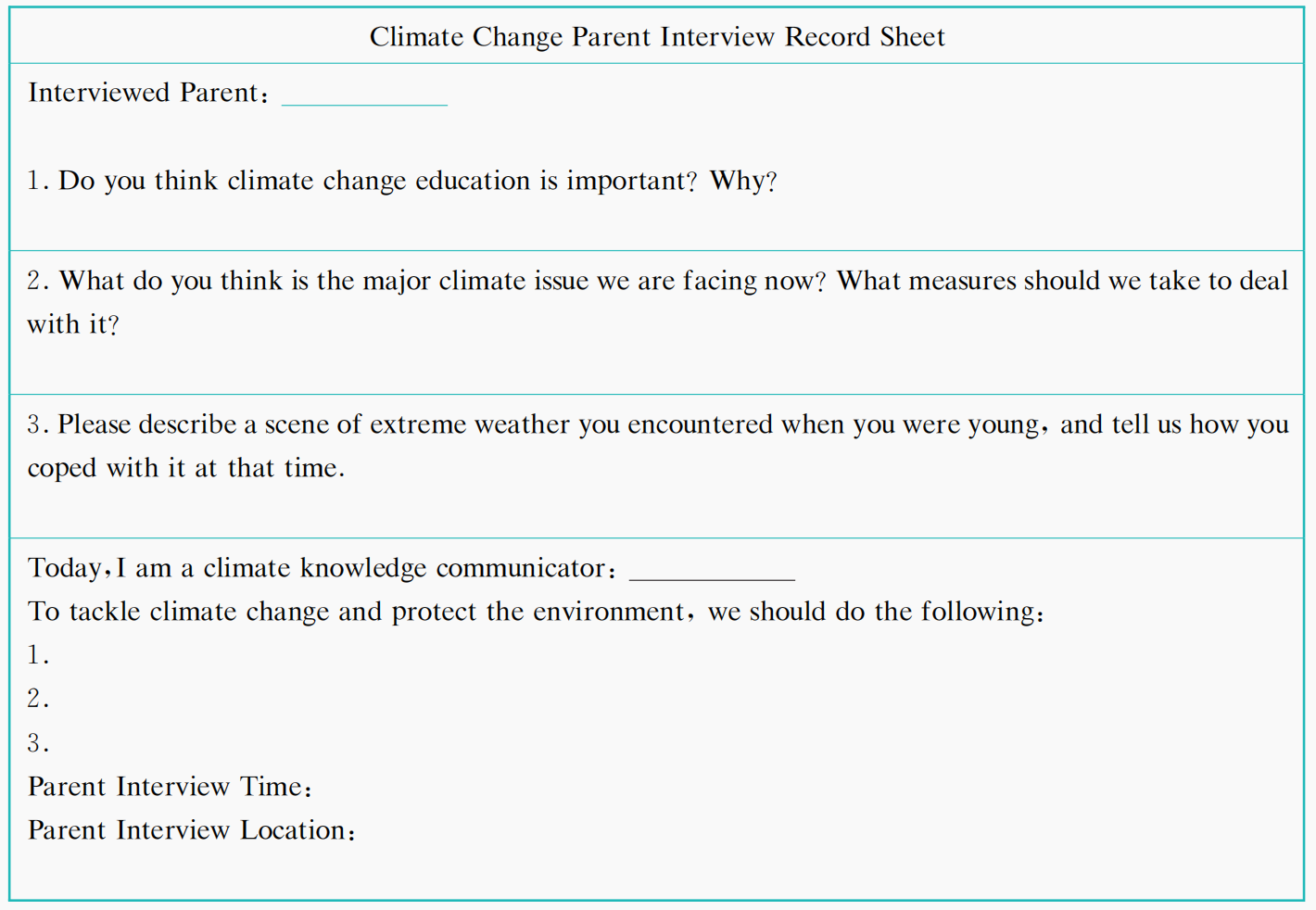East side of 7th Floor, No. 3663, North
Zhongshan Road, Shanghai, China, 200062
Tel: +86 21 6223 2322
www.smile.ecnu.edu.cn
Research Background
The important task of secondary vocational education is to serve as the basic education for the system of cultivating applied talents. It has become a pressing issue for all secondary vocational schools to address how to raise the awareness among vocational students about the serious impacts of climate change on human economic and social development, human health, and natural ecosystems. In addition, it is crucial to explore how to integrate students’ specialized fields of study into comprehensive climate change education activities within vocational education.
President Xi Jinping emphasized the “strategic importance of ecological protection” during his Northeast inspection tour, stressing that “ecology is a resource and ecology is productivity.” In the winter of 2023, the Harbin Municipal Government, focusing on the attraction of unique environments, vigorously developed the ice and snow tourism industry. The cold climate is a prerequisite for the development of the tourism economy in Northeast China, and the occurrence of warm winters undoubtedly affects the development of winter tourism in this region. Raising young people’s awareness of climate change and promoting environmental protection concepts are crucial to the sustainable development of Northeast China. As emphasized in the Berlin Declaration on Education for Sustainable Development, sustainable development education can cultivate learners’ cognitive and non-cognitive skills, such as critical thinking, collaborative abilities, problem-solving capabilities, resilience, systematic and creative thinking in the face of complex situations and risks. For students majoring in nursing, it is essential to pay special attention to the impact of climate change on human health, thereby applying their professional knowledge to real-life situations, fostering noble professional ideals of serving people, and caring for lives.
In December 2023, Harbin Health School launched comprehensive climate change education activities in Class 10, Grade 2023, as a pilot class. Over a period of two months, students conducted a series of activities, including surveys, research, family interviews, and community lectures. A questionnaire survey showed that the project not only enriched students’ science knowledge, but also significantly improved their cooperation and communication skills, with a satisfaction rate of 90%.
Project Design
Taking into account the personalities, interests, and age characteristics of secondary vocational students, the teacher designed the climate change education as a student-centered, exploratory and comprehensive activity (see Figure 1).

Figure 1 Comprehensive Activity Design Framework
Overall Objectives: To provide nursing students with environmental knowledge, values, and attitudes to adapt to the new climate realities through this comprehensive climate change education activity. By studying the impact of climate change on human health, students will use their professional knowledge and skills to serve the community and promote a noble professional ideal.
Specific Objectives: To enhance students’ understanding of the current climate change situation in Northeast China and foster their environmental awareness. During the event, students will grasp methods of coping with extreme weather and improve their survival skills. They will also explore the relationship between climate characteristics and diseases, thereby enhancing their professional knowledge.
Project Implementation
1. Conducting Climate Change Education Research Activities
From November 7th to 12th, 2023, Class 10, Grade 1 of the nursing program was selected as the pilot class for activity recruitment and grouping. In conducting climate change education for secondary vocational students, the principles of being close to reality, professionalism, and daily life were adhered to. The theme of the comprehensive climate change education activity was determined as “Coping with Climate, Serving with Professionalism”.
On November 5th, 2023, Northeast China was affected by a widespread heavy snow and rainstorm, resulting in school closures and flight cancellations in multiple regions. Teachers took this opportunity of the recent extreme weather experienced by students to initiate the climate change education by issuing a recruitment notice to all class members.
Climate Change Education Comprehensive Activity Recruitment Letter

The principle of respecting students’ wishes and encouraging their active participation is upheld in determining who will take part in the comprehensive climate change education activity. Any student who is willing to participate is welcome to join. The design of this comprehensive activity is grounded in promoting students’ development, with emphasis on fostering their sense of participation and nurturing their abilities. Teachers have devised three activities: a questionnaire survey, social follow-up interviews, and project research, aiming to provide students with opportunities to showcase their strengths. Based on their individual interests, personalities, and abilities, students autonomously select their preferred comprehensive activity groups and negotiate to elect group leaders. Due to the large number of participants, the project research has been divided into four groups (see Table 1).
Table 1 Project recruitment and grouping

2. Conducting Exploration Activities on Climate Change Education
From November 13th to December 3rd, 2023, the implementation phase of this climate change education exploration activity was carried out.
Step 1: Conduct Questionnaire Surveys and Social Follow-up Interviews
Teachers assigned the content for the questionnaire survey group, and students researched to identify 20 hot topics related to climate change. Through collective discussion, 10 issues closely linked to daily lives were determined. Students were encouraged to use online mini-programs to create questionnaires, distribute them, and analyze the survey results under guidance, culminating in the compilation of survey reports. Making use of their own networks, students actively shared the questionnaires to obtain more valuable survey data.
Table 2 Outline of social follow-up questions

Step 3: Determine Project-based Learning Themes and Design Frameworks
Teachers and students discussed the survey results and interview transcripts together to determine the research themes for project-based learning. Group discussions ensued to design the project learning frameworks (see Table 3). Teachers emphasized inquiry-based learning and taught students how to retrieve literature and research materials, which fostered a sense of cooperation and teamwork. Adopting a feedback-interactive approach, teachers organized two interim group learning reports during the research process, enabling mutual learning and evaluation among groups. After each report, teachers provided timely feedback and suggestions, enriching and deepening the research content of each group.
Table 3 Project research framework

3. Launching Climate Change Education Publicity Activities
From December 4th to December 17th, 2023, the comprehensive activity outcomes were showcased in classes and the school.
Firstly, project learning groups shared their research findings with the entire class during a class meeting on climate change education, engaging in collaborative learning, mutual progress, and evaluation activities. After all presentations, classmates voted to select one group to represent the class and demonstrate their findings to the entire school. Following the class meeting, students were encouraged to create health and environmental posters that showcased their knowledge of climate change, extreme weather responses, and climate protection measures.
Secondly, the social follow-up activity was extended by inviting all class members to participate in parent interviews, where they shared climate knowledge with their parents.
Thirdly, on May 10th, 2024, the eve of Nurses’ Day, ten students from the class visited the Zhaolin Community, using their nursing skills to offer volunteer services such as blood pressure and blood sugar measurements. In the process, they promoted knowledge about climate protection and health hygiene, and advised community residents to adjust their diets and lifestyles to maintain good health.

Effectiveness & Reflections
The comprehensive implementation of regional climate change education activities has significantly contributed to raising the awareness of secondary vocational students towards climate change, fostering their collaboration skills, creative thinking, and inspiring them to take responsible actions, thereby nurturing them into health professionals with both moral integrity and outstanding technical skills.
This comprehensive activity, spanning from November 2023 to May 2024, was short in duration but yielded rich research results. Among the 45 students in Nursing Class 10, Grade 1, 32 participated, accounting for approximately 70% of the total class. During the project presentation and evaluation, the 13 students who did not participate in practical activities formed an evaluation committee with the group leaders to vote for the outstanding performance groups.
The activity achieved its goal of active participation and learning for all. The questionnaire survey team collected 193 online responses and completed a survey data analysis report, while the social follow-up team randomly interviewed 10 individuals and compiled videos, photos, and interview transcripts. These two sets of data provided a solid basis for the project learning group’s topic selection.
Project Group 1 gained a comprehensive understanding of geographical knowledge by mastering the latitude and longitude, topography, and climatic characteristics and patterns of Northeast China.
Project Group 2 delved into extreme climate changes in Northeast China through data research. Historical records indicate that there were three major floods and three severe droughts between 1949 and 2007. Students used video materials to teach their peers about coping strategies for floods, droughts, severe cold, heavy snow, and sandstorms.
Project Group 3 examined climate change in Northeast China through literature review. Zhao Zongci et al. predicted a significant warming of over 3°C and possible increased precipitation in the region by the late 21st century based on 23 global climate models. Zeng Xiaofan et al. used the ECHAM5/MPI-OM model to conclude that the average temperature in the Songhua River Basin has continued to rise since 1980.
Project Group 4 investigated the impact of climate change on human health and found that high temperatures affect sleep quality, potentially leading to fatigue, anxiety, and depression. Climate warming may aggravate allergic symptoms and increase the risk of skin cancer. Differences in climate and diet between the north and south contribute to varying prevalence rates of cardiovascular diseases, hypertension, and diabetes. Based on their nursing expertise, students proposed strategies to adapt to climate change and protect human health, and raise public awareness of the health implications of climate change. A total of 25 climate change parent interviews were collected, and 10 students engaged in community volunteer service, distributing 30 copies of the “Climate Change and Health” leaflet.
At the end of the activity, the students expressed their enthusiasm and appreciation for the comprehensive climate education program.
Student Shi remarked, “During this period, our group studied the climate issues of Northeast China through WeChat videos. Even after our discussions, we continued to review our coursework together, and I even scored 100 on the weekly test.”
Student Li shared, “I finally managed to create a questionnaire by using a mini-program. I realized the importance of rigor and a solid foundation in Chinese language knowledge. I’m grateful to my teacher for constantly helping me proofread the questionnaire.”
Student Cao said, “I remember that day of the interview was particularly cold. At first, I encountered many rejections when interviewing strangers, but I didn’t give up. I believe perseverance will surely get the job done!”
Student Ren expressed, “It was my first time participating in volunteer service. I felt so proud when I measured blood pressure for community residents and disseminated knowledge about ‘Climate and Health.’ I can use my professional knowledge and skills to help more people in the future.”
Following the implementation of the comprehensive climate change inquiry activity, we also engaged in introspection:
Firstly, the design of comprehensive activities should be in line with learners’ academic situations, continuously attend to their motivation, and stimulate their drive. In comprehensive activities of climate education, we design various types of activities that enable learners to exert their strengths in multiple intelligences, so that they can perform learning tasks competently and excellently. Group learning in project-based learning fosters a relaxed, harmonious, and free learning environment, maximizing each student’s autonomy and allowing individuality to flourish.
Secondly, it’s necessary to establish the central role of learners, empowering them to engage in independent inquiry and apply what they’ve learned. Teachers recommend combining online and offline methods for research, such as libraries, bookstores, Baidu Scholar, and CNKI. Students voluntarily divide tasks within their weekend groups, conduct research, and mutually recommend websites for information retrieval. Students delve into tasks, constructing knowledge meaningfully and transforming it into transferable learning abilities. Through project-based learning, students’ motivation and efficiency in academic courses improve significantly, which is reflected in higher pass rates for project participants compared to their classmates in final exams.
Thirdly, boundaries between disciplines should be broken down with an integrated design across multiple subjects that combines cognitive learning with social growth. Problem-solving permeates the entire project-based learning process, as students continuously learn within a series of task frameworks, thinking and exploring like subject experts. Questions like “What is the future trend of climate change in Northeast China?”, “What factors influence climate change?”, “What measures are needed to protect the environment?” and “How can nursing expertise help prevent diseases caused by cold climates in Northeast residents?” are explored. Research-based, practical, and socialized learning fosters the transformation of fragmented multidisciplinary knowledge into a comprehensive force for exploring the world, fostering coherence and holistic understanding in learning and life.
Fourthly, specific requirements in comprehensive practical activities enhance students’ comprehensive abilities. Submitting high-quality assignments on time requires reasonable task distribution within groups, which greatly enhances students’ teamwork and communication skills. To better present research findings, students have mastered PPT creation, survey questionnaire applications, micro-video recording and editing, steadily improving their information technology skills and laying a solid foundation for adapting to the information society.
Lastly, most of the questionnaire responses on climate change in Northeast China come from Heilongjiang. Teachers and students should appropriately communicate and collaborate with other vocational schools in the region to form a climate change education community, thereby improving survey reliability and validity and raising awareness among more vocational students about the importance of environmental protection. During project-based learning, unclear task distribution in some groups led to heavy workloads for group leaders. To prevent this, teachers should listen to group task reports to ensure full participation. The depth and breadth of the social follow-up questions on climate change need to be improved. Next time, extensive collection of questions before screening and implementation can enhance students’ deep thinking abilities.
Provided by ShuangChen, Lecturer of Harbin Health School